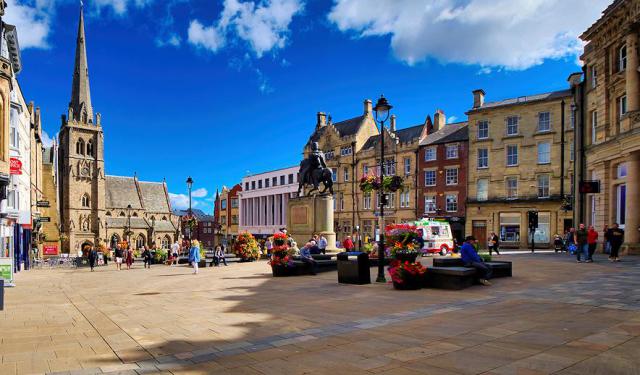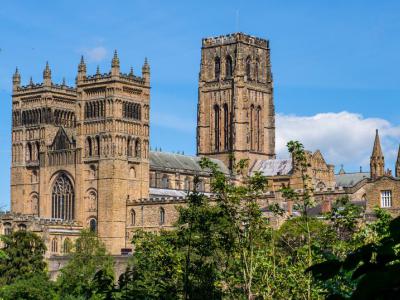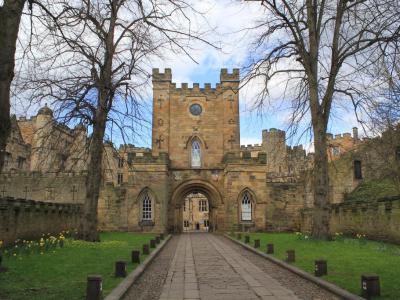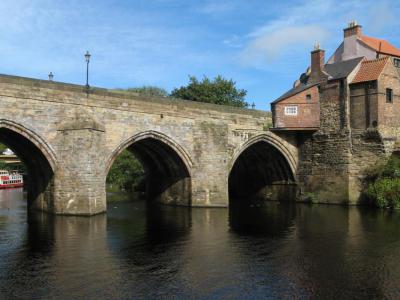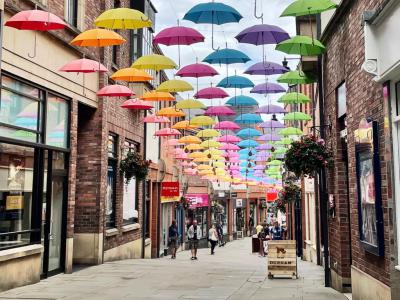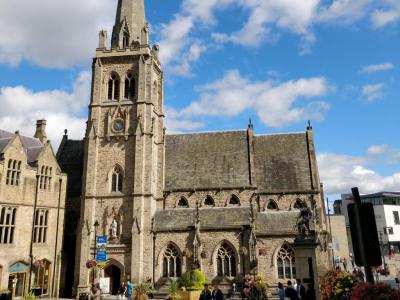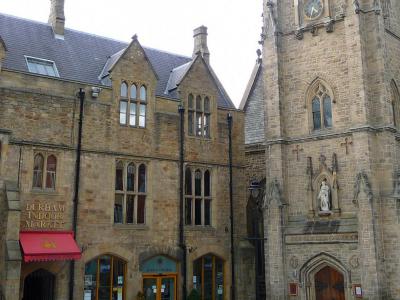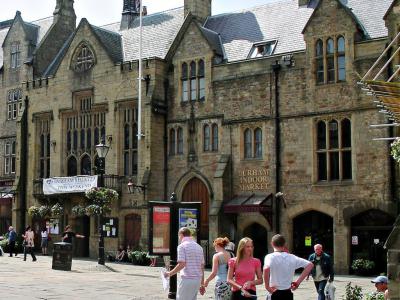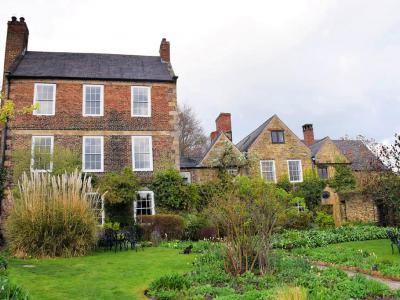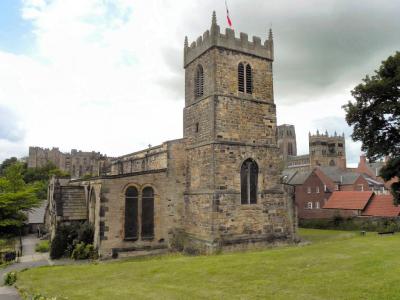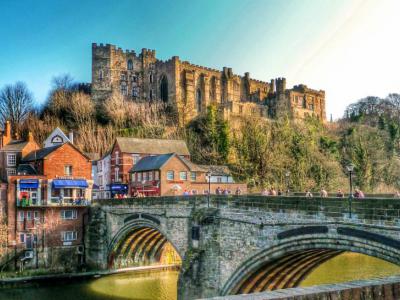Audio Guide: Durham Introduction Walking Tour (Self Guided), Durham
According to the legend, it all started with a missing cow. Back in 995, a group of monks fleeing Viking raiders were hauling around the remains of Saint Cuthbert when their saintly cargo decided to stop moving. No matter how hard they tried, the bier wouldn’t budge-until a milkmaid chasing her lost dun cow wandered past. ("Dun" is a dull shade of brownish grey. ) The monks took the hint, followed her uphill to a loop in the River Wear, and here you go-Durham was born. Well, eventually.
The name Durham comes from a mix of Old English and Old Norse-dun meaning hill and holme meaning island-which is pretty much what the city looks like: a hill wrapped in water. From the start, it wasn’t just scenic. Durham became the stronghold of the Prince Bishops, who weren’t your average clergymen-they could raise armies, collect taxes, and rule like kings without technically being one.
Dominating the skyline are two heavy-hitters: Durham Cathedral, a thousand-year-old masterpiece of Romanesque architecture-think massive stone columns, rounded arches, and a nave that seems to reach for the heavens. It’s home to some rather legendary figures too: Saint Cuthbert, the Venerable Bede, and, in a cinematic twist, a bit of Hogwarts-the cloisters doubled as a film set for Harry Potter. Just next door is Durham Castle, built in 1072 and now full of college students. Together, they form a UNESCO World Heritage double act-stone, scholars, and centuries of history, all in one view.
But Durham doesn’t stop at postcard views. Elvet Bridge and Framwellgate Bridge still carry walkers across the river, just as they did hundreds of years ago. The Market Hall buzzes with local life just as it did in the Middle Ages, while High Street and Prince Bishops Place balance modern shops with architectural throwbacks. You’ll also find Saint Nicholas Church still holding services and Durham Town Hall still hosting speeches, ceremonies, and a bit of civic pride.
Need a breather? Crook Hall offers gardens straight out of a storybook, while Saint Margaret’s Church proves you don’t have to be massive to be magnificent. The Botanic Garden, just beyond the university, ditches medieval stone for bamboo groves and global flora-keeping things, and the air, fresh.
So yes, it’s small. But don’t be fooled-Durham packs a thousand years of drama, devotion, and the occasional bovine plot twist into its winding streets. Come for the legends, stay for the view, and leave with more stories than you bargained for.
The name Durham comes from a mix of Old English and Old Norse-dun meaning hill and holme meaning island-which is pretty much what the city looks like: a hill wrapped in water. From the start, it wasn’t just scenic. Durham became the stronghold of the Prince Bishops, who weren’t your average clergymen-they could raise armies, collect taxes, and rule like kings without technically being one.
Dominating the skyline are two heavy-hitters: Durham Cathedral, a thousand-year-old masterpiece of Romanesque architecture-think massive stone columns, rounded arches, and a nave that seems to reach for the heavens. It’s home to some rather legendary figures too: Saint Cuthbert, the Venerable Bede, and, in a cinematic twist, a bit of Hogwarts-the cloisters doubled as a film set for Harry Potter. Just next door is Durham Castle, built in 1072 and now full of college students. Together, they form a UNESCO World Heritage double act-stone, scholars, and centuries of history, all in one view.
But Durham doesn’t stop at postcard views. Elvet Bridge and Framwellgate Bridge still carry walkers across the river, just as they did hundreds of years ago. The Market Hall buzzes with local life just as it did in the Middle Ages, while High Street and Prince Bishops Place balance modern shops with architectural throwbacks. You’ll also find Saint Nicholas Church still holding services and Durham Town Hall still hosting speeches, ceremonies, and a bit of civic pride.
Need a breather? Crook Hall offers gardens straight out of a storybook, while Saint Margaret’s Church proves you don’t have to be massive to be magnificent. The Botanic Garden, just beyond the university, ditches medieval stone for bamboo groves and global flora-keeping things, and the air, fresh.
So yes, it’s small. But don’t be fooled-Durham packs a thousand years of drama, devotion, and the occasional bovine plot twist into its winding streets. Come for the legends, stay for the view, and leave with more stories than you bargained for.
How it works: Download the app "GPSmyCity: Walks in 1K+ Cities" from Apple App Store or Google Play Store to your mobile phone or tablet. The app turns your mobile device into a personal tour guide and its built-in GPS navigation functions guide you from one tour stop to next. The app works offline, so no data plan is needed when traveling abroad.
Durham Introduction Walking Tour Map
Guide Name: Durham Introduction Walking Tour
Guide Location: England » Durham (See other walking tours in Durham)
Guide Type: Self-guided Walking Tour (Sightseeing)
# of Attractions: 10
Tour Duration: 2 Hour(s)
Travel Distance: 2.6 Km or 1.6 Miles
Author: DanaOffice
Sight(s) Featured in This Guide:
Guide Location: England » Durham (See other walking tours in Durham)
Guide Type: Self-guided Walking Tour (Sightseeing)
# of Attractions: 10
Tour Duration: 2 Hour(s)
Travel Distance: 2.6 Km or 1.6 Miles
Author: DanaOffice
Sight(s) Featured in This Guide:
- Durham Cathedral
- Durham Castle
- Elvet Bridge
- High Street and Prince Bishops Place
- St. Nicholas Church
- Durham Town Hall
- Durham Market Hall
- Crook Hall
- St. Margaret's Church
- Framwellgate Bridge
1) Durham Cathedral (must see)
Long before Durham had a cathedral, a university, or even a postcode, there was Lindisfarne-also known as Holy Island. Perched off England’s northeast coast, it was the spiritual launchpad of the 6th century. Saints came, sermons were preached, and in time, Saint Cuthbert took the spotlight. He died in 687, but his story was far from over.
Jump ahead to 875, and in come the Vikings-loud, uninvited, and ready to shake things up. In response, the monks packed up Cuthbert’s body and hit the road-well, the dirt path. They wandered for years, relics in tow, dodging raiders and praying for peace. According to legend, guidance came not from angels, but from a milkmaid looking for a missing cow. Naturally. They led the monks to a high bend in the River Wear, where Cuthbert’s coffin refused to budge. Clearly, this was the place.
With local support, the monks raised a humble chapel of timber and wattle-“The White Church.” Pilgrims began trickling in, including King Canute, who was a prominent Viking king, who reportedly came barefoot. In 998, the White Church got a stone makeover. And by 1018, it was promoted to cathedral.
In 1093, the groundwork began for the grand cathedral that still towers over Durham today. Built by the new Norman rulers, it was designed not just as a place of worship, but as a fitting home for two of Britain’s most revered figures-Saint Cuthbert and the scholar-monk Bede.
Inside, the architecture starts to flirt with Gothic style-think ribbed ceilings, pointy arches, and an upper gallery that cleverly hides the building’s support system. But overall, it still feels Romanesque: solid, heavy, and more castle than cathedral in mood.
Cuthbert’s final resting place lies at the east end, surrounded by fragments of his original coffin and the company of 22 other interred souls-some under chapels, some beneath the transepts, and a few possibly photobombing your visit from the old meeting room, the chapter house.
In 1986, Durham Cathedral earned its stripes as a UNESCO World Heritage Site-hailed as one of Europe’s finest Norman buildings and a stone-and-mortar reminder that the Norman Conquest left more than just a line in the history books.
Jump ahead to 875, and in come the Vikings-loud, uninvited, and ready to shake things up. In response, the monks packed up Cuthbert’s body and hit the road-well, the dirt path. They wandered for years, relics in tow, dodging raiders and praying for peace. According to legend, guidance came not from angels, but from a milkmaid looking for a missing cow. Naturally. They led the monks to a high bend in the River Wear, where Cuthbert’s coffin refused to budge. Clearly, this was the place.
With local support, the monks raised a humble chapel of timber and wattle-“The White Church.” Pilgrims began trickling in, including King Canute, who was a prominent Viking king, who reportedly came barefoot. In 998, the White Church got a stone makeover. And by 1018, it was promoted to cathedral.
In 1093, the groundwork began for the grand cathedral that still towers over Durham today. Built by the new Norman rulers, it was designed not just as a place of worship, but as a fitting home for two of Britain’s most revered figures-Saint Cuthbert and the scholar-monk Bede.
Inside, the architecture starts to flirt with Gothic style-think ribbed ceilings, pointy arches, and an upper gallery that cleverly hides the building’s support system. But overall, it still feels Romanesque: solid, heavy, and more castle than cathedral in mood.
Cuthbert’s final resting place lies at the east end, surrounded by fragments of his original coffin and the company of 22 other interred souls-some under chapels, some beneath the transepts, and a few possibly photobombing your visit from the old meeting room, the chapter house.
In 1986, Durham Cathedral earned its stripes as a UNESCO World Heritage Site-hailed as one of Europe’s finest Norman buildings and a stone-and-mortar reminder that the Norman Conquest left more than just a line in the history books.
2) Durham Castle (must see)
Just up from the River Wear’s wooded curve, Durham Castle holds court on its peninsula perch. Construction kicked off in 1072 on orders from William the Conqueror-because what’s the point of conquering a country if you can’t plant a stone fortress to prove it? Things got off to a rocky start: the local nobleman put in charge rebelled and lost both his job and his head. The castle then passed to the Bishops of Durham, who weren’t just churchmen-they ruled like mini-monarchs for the next 700 years.
The castle’s layout followed the Norman playbook: a central mound surrounded by walled courtyards known as baileys. By the time Henry VIII rolled in, the place had shed some of its battle gear and started dressing like a palace. In the early 1600s, it played host to royalty-including a Scottish king who’d later moonlight as England’s monarch. Clearly, the castle was no stranger to fine company by that point.
In 1832, the drawbridge dropped for students. The newly founded University of Durham moved in, and scholars have been living in this historic stronghold ever since. Its massive stone keep still stands guard, and the courtyard-with its original gatehouse and moat-feels straight out of a medieval daydream. Inside, you’ll find a 500-year-old working kitchen, a Great Hall straight from a fantasy film set (no, really-it featured in Harry Potter), and a black oak staircase grand enough to command a bow.
Just outside, Palace Green once hosted Durham’s central market, but today it’s more likely to host tourists, students, and the occasional ghost story. They say a university tutor still haunts the cobbles-possibly looking for overdue essays.
Since 1986, Durham Castle has been part of a UNESCO World Heritage duo with its neighbor, the cathedral. Together, they’ve earned top marks in architecture, atmosphere, and ancient intrigue. And yes-you can visit. And maybe pack a garlic clove… just in case.
The castle’s layout followed the Norman playbook: a central mound surrounded by walled courtyards known as baileys. By the time Henry VIII rolled in, the place had shed some of its battle gear and started dressing like a palace. In the early 1600s, it played host to royalty-including a Scottish king who’d later moonlight as England’s monarch. Clearly, the castle was no stranger to fine company by that point.
In 1832, the drawbridge dropped for students. The newly founded University of Durham moved in, and scholars have been living in this historic stronghold ever since. Its massive stone keep still stands guard, and the courtyard-with its original gatehouse and moat-feels straight out of a medieval daydream. Inside, you’ll find a 500-year-old working kitchen, a Great Hall straight from a fantasy film set (no, really-it featured in Harry Potter), and a black oak staircase grand enough to command a bow.
Just outside, Palace Green once hosted Durham’s central market, but today it’s more likely to host tourists, students, and the occasional ghost story. They say a university tutor still haunts the cobbles-possibly looking for overdue essays.
Since 1986, Durham Castle has been part of a UNESCO World Heritage duo with its neighbor, the cathedral. Together, they’ve earned top marks in architecture, atmosphere, and ancient intrigue. And yes-you can visit. And maybe pack a garlic clove… just in case.
3) Elvet Bridge
Back in the 12th century, Prince-Bishop Pudsey was busy putting his stamp on northern England. Among his legacy projects was a sturdy new bridge to link Durham’s cathedral side with the suburb of Elvet. Construction on Elvet Bridge kicked off around 1160, and, in true medieval fashion, dragged on for decades. By 1228, it was still a work in progress-despite spiritual incentives in the form of indulgences. Apparently, even divine motivation can’t speed up stonework.
The bridge you see today boasts ten arches, the kind you'd expect on a Roman aqueduct after a subtle Gothic makeover. Its slight pointiness hints at evolving tastes, but the structure remains remarkably intact. In its medieval heyday, this wasn’t just a bridge-it was a mini-neighborhood. Chapels marked each end, defensive gates kept an eye out, and shops and dwellings were built right on top, making it feel more like a bustling street than a river crossing.
Of the original chapels, only Saint Andrew’s still hangs on at the eastern end. Saint James’s, sadly, didn’t survive the centuries.
Today, Elvet Bridge carries only foot traffic and claims to be the narrowest bridge with buildings ever built in Europe. Whether or not that's strictly true, it’s a charming stroll-and a photographer’s dream. The views of the Cathedral, rising like a stone crown above the wooded banks of the River Wear, are nothing short of cathedral-worthy.
And if you’re feeling ambitious, a scenic footpath loops all the way around the cathedral. Not a bad detour-just watch your step. Some stones here have been walked on for nearly a thousand years.
The bridge you see today boasts ten arches, the kind you'd expect on a Roman aqueduct after a subtle Gothic makeover. Its slight pointiness hints at evolving tastes, but the structure remains remarkably intact. In its medieval heyday, this wasn’t just a bridge-it was a mini-neighborhood. Chapels marked each end, defensive gates kept an eye out, and shops and dwellings were built right on top, making it feel more like a bustling street than a river crossing.
Of the original chapels, only Saint Andrew’s still hangs on at the eastern end. Saint James’s, sadly, didn’t survive the centuries.
Today, Elvet Bridge carries only foot traffic and claims to be the narrowest bridge with buildings ever built in Europe. Whether or not that's strictly true, it’s a charming stroll-and a photographer’s dream. The views of the Cathedral, rising like a stone crown above the wooded banks of the River Wear, are nothing short of cathedral-worthy.
And if you’re feeling ambitious, a scenic footpath loops all the way around the cathedral. Not a bad detour-just watch your step. Some stones here have been walked on for nearly a thousand years.
4) High Street and Prince Bishops Place
Durham’s High Street doesn’t just take you places-it loops you in. Literally. The road arcs like a horseshoe from Silver Street to Saddler Street, curving toward the river before circling back with purpose. Along the way, you’ll find a rotating lineup of shops-big names, niche newcomers, and blink-and-you’ll-miss-’em pop-ups. The sidewalks stay busy with a blend of locals, out-of-towners, and students trying to juggle shopping with studying.
Just a few minutes from Durham Castle is Prince Bishops Place, the city’s retail reboot built in the late ’90s on what was once a multi-storey car park. The result was a polished shopping hub with more than forty outlets, including offbeat boutiques and familiar favorites. Think of it as a cathedral to commerce-minus the stained glass, plus a car park and reliable public transport links.
Together, the High Street and Prince Bishops Place pack serious shopping punch. And with their blend of medieval façades and modern storefronts, you get a good dose of Durham’s charm even while picking out socks. Who said retail and heritage can’t get along?
Just a few minutes from Durham Castle is Prince Bishops Place, the city’s retail reboot built in the late ’90s on what was once a multi-storey car park. The result was a polished shopping hub with more than forty outlets, including offbeat boutiques and familiar favorites. Think of it as a cathedral to commerce-minus the stained glass, plus a car park and reliable public transport links.
Together, the High Street and Prince Bishops Place pack serious shopping punch. And with their blend of medieval façades and modern storefronts, you get a good dose of Durham’s charm even while picking out socks. Who said retail and heritage can’t get along?
5) St. Nicholas Church
Back in the early 1100s, Prince-Bishop Ranulf Flambard decided the green patch between his castle and cathedral could use a little divine commerce. So, he cleared it out and turned it into a market square, plopping down a church dedicated to none other than Saint Nicholas. Not just the guy with the sleigh-this Saint Nic was the all-purpose patron saint: merchants, sailors, archers, brewers, pawnbrokers, even students and reformed thieves got a nod.
The original church had all the medieval trimmings: buttressed nave, squared-off tower, and a side wall that pulled double duty as part of the city wall. Cemeteries flanked both sides, just to round out the ambiance. After centuries of patch-ups and wear, the whole thing was demolished in 1857-except for five bells and an 18th-century font, which were politely shown the door and saved for the next act.
What rose in its place in 1858 was a near replica, drawn up by architect J. B. Pritchett of Darlington. The Illustrated London News even dubbed it “the most beautiful specimen of church architecture in the north of England.” Mic drop.
The current church is all Victorian charm, dressed in neat layers of sandstone and topped with a crisp slate roof. It’s got aisles, a proper south porch with attitude, and an octagonal spire that points skyward like it’s trying to get better Wi-Fi. Look closely and you’ll spot tiny fairy-tale windows peeking out-those are called lucarnes, for the architecture fans keeping score. Over the double doors, Saint Nicholas still watches the scene, holding a ship like he's ready to bless your voyage-or your shopping trip.
The original church had all the medieval trimmings: buttressed nave, squared-off tower, and a side wall that pulled double duty as part of the city wall. Cemeteries flanked both sides, just to round out the ambiance. After centuries of patch-ups and wear, the whole thing was demolished in 1857-except for five bells and an 18th-century font, which were politely shown the door and saved for the next act.
What rose in its place in 1858 was a near replica, drawn up by architect J. B. Pritchett of Darlington. The Illustrated London News even dubbed it “the most beautiful specimen of church architecture in the north of England.” Mic drop.
The current church is all Victorian charm, dressed in neat layers of sandstone and topped with a crisp slate roof. It’s got aisles, a proper south porch with attitude, and an octagonal spire that points skyward like it’s trying to get better Wi-Fi. Look closely and you’ll spot tiny fairy-tale windows peeking out-those are called lucarnes, for the architecture fans keeping score. Over the double doors, Saint Nicholas still watches the scene, holding a ship like he's ready to bless your voyage-or your shopping trip.
6) Durham Town Hall
Durham’s Town Hall has been running the city show since the 14th century-and after a recent glow-up, it’s finally open to curious visitors again. Sitting proudly on the west side of the old Market Place, it’s sometimes confused with the nearby Guild Hall, but don’t be fooled-they’re neighbors, not twins.
The original hall popped up in 1356 as a meeting spot for merchant guilds, likely over ale and heated debates about wool prices. That modest wooden structure didn’t last-Prince-Bishop Cuthbert Tunstall gave it a 1535 makeover, and then in 1665, another Bishop, John Cosin, decided it needed a second facelift. They were clearly on to something, because part of Cosin’s handiwork still stands today.
Round the back is what folks call the "new" Town Hall, though it's been around since 1851. It comes in full Perpendicular Gothic flair, all pointy windows and dramatic lines. Inside, the Great Hall stretches a stately 72 feet, with a hammer-beam roof that shows off like it’s auditioning for a Gothic cathedral. Below, plaques salute Durham’s local legends in style.
And while we’re reminiscing: meet Count Boruwlaski, an 18th-century court favorite who stood just over three feet tall and went by 'the Little Count.' He charmed royals across Europe-and now his personal belongings have settled here, clearly preferring good company.
The Town Hall also guards the original city charter, ceremonial swords, and pikes-because every good city needs a little medieval pageantry under its roof.
The original hall popped up in 1356 as a meeting spot for merchant guilds, likely over ale and heated debates about wool prices. That modest wooden structure didn’t last-Prince-Bishop Cuthbert Tunstall gave it a 1535 makeover, and then in 1665, another Bishop, John Cosin, decided it needed a second facelift. They were clearly on to something, because part of Cosin’s handiwork still stands today.
Round the back is what folks call the "new" Town Hall, though it's been around since 1851. It comes in full Perpendicular Gothic flair, all pointy windows and dramatic lines. Inside, the Great Hall stretches a stately 72 feet, with a hammer-beam roof that shows off like it’s auditioning for a Gothic cathedral. Below, plaques salute Durham’s local legends in style.
And while we’re reminiscing: meet Count Boruwlaski, an 18th-century court favorite who stood just over three feet tall and went by 'the Little Count.' He charmed royals across Europe-and now his personal belongings have settled here, clearly preferring good company.
The Town Hall also guards the original city charter, ceremonial swords, and pikes-because every good city needs a little medieval pageantry under its roof.
7) Durham Market Hall
Just off Durham’s Market Place, Durham Market Hall keeps things buzzing under its Victorian iron-and-glass canopy. A short stroll from the Cathedral and Castle, it trades cobblestones for chatter, fresh coffee, and the kind of local advice you won’t get from a brochure. It’s less “historic monument,” more “living, breathing snack-and-souvenir generator.”
Inside, it’s equal parts food haven and treasure hunt. One aisle might tempt you with bread still warm from the oven, while the next offers vintage records, hand-knit socks, or jars of local chutney that somehow end up in your bag. Butchers and bakers hold down the classics, while indie makers, booksellers, and florists keep things fresh. It’s ideal for piecing together a riverside picnic, grabbing a quirky souvenir, or scoring a hot lunch that won’t cost more than your bus fare.
Entry’s straight from the Market Place, and the vibe is as unfussy as the prices. It’s dry in winter, cool in summer, stroller- and grandparent-friendly, and just chaotic enough to be fun. Mornings offer the widest selection, and if you’ve got a reusable bag handy, all the better-produce here has a way of jumping in when you’re not looking. Most stalls take cards, but a couple of coins might score you a surprise treat.
Pair it with a look inside the Town Hall, a ramble along the River Wear, and the climb to Durham Cathedral, and you’ve just wrapped up a day that hits local, scenic, and snacky in under three hours.
Inside, it’s equal parts food haven and treasure hunt. One aisle might tempt you with bread still warm from the oven, while the next offers vintage records, hand-knit socks, or jars of local chutney that somehow end up in your bag. Butchers and bakers hold down the classics, while indie makers, booksellers, and florists keep things fresh. It’s ideal for piecing together a riverside picnic, grabbing a quirky souvenir, or scoring a hot lunch that won’t cost more than your bus fare.
Entry’s straight from the Market Place, and the vibe is as unfussy as the prices. It’s dry in winter, cool in summer, stroller- and grandparent-friendly, and just chaotic enough to be fun. Mornings offer the widest selection, and if you’ve got a reusable bag handy, all the better-produce here has a way of jumping in when you’re not looking. Most stalls take cards, but a couple of coins might score you a surprise treat.
Pair it with a look inside the Town Hall, a ramble along the River Wear, and the climb to Durham Cathedral, and you’ve just wrapped up a day that hits local, scenic, and snacky in under three hours.
8) Crook Hall (must see)
Crook Hall is what happens when 800 years of home improvements get wildly out of hand. It started out in the 1200s as a simple medieval house-just one big hall and a draft-blocking hallway. Over time, owners kept adding bits and pieces. By the 1600s, it looked more like a fancy country manor, and in the 1700s, someone added a brick front to keep up with the fashion of the day. Now it’s an 11-room mashup of old styles, surrounded by gardens that switch themes faster than a costume party.
The name comes from its original owner, Peter del Croke-whose ancestor Aimery was handed the manor of “Sydgate” in 1217. Somewhere along the line, “Sydgate” took a left turn and became Crook Hall. These days, the house overlooks the River Wear, with a frame-worthy view all the way up to Durham Cathedral.
But the real scene-stealer is the garden. Spanning five acres, it’s less of a backyard and more of a floral choose-your-own-adventure. There’s a Shakespeare garden, a fruit tree orchard, a silver-and-white garden, a walled hideaway, and even a Cathedral lawn. Add a proper greenhouse, a kitchen garden, and a hedge maze designed to test both your memory and your patience.
And just to keep things interesting, there’s a ghost. The White Lady has been known to ring bells and rearrange dinner plans-literally. Consider it your reminder that no house this old gets to be quiet for long.
The name comes from its original owner, Peter del Croke-whose ancestor Aimery was handed the manor of “Sydgate” in 1217. Somewhere along the line, “Sydgate” took a left turn and became Crook Hall. These days, the house overlooks the River Wear, with a frame-worthy view all the way up to Durham Cathedral.
But the real scene-stealer is the garden. Spanning five acres, it’s less of a backyard and more of a floral choose-your-own-adventure. There’s a Shakespeare garden, a fruit tree orchard, a silver-and-white garden, a walled hideaway, and even a Cathedral lawn. Add a proper greenhouse, a kitchen garden, and a hedge maze designed to test both your memory and your patience.
And just to keep things interesting, there’s a ghost. The White Lady has been known to ring bells and rearrange dinner plans-literally. Consider it your reminder that no house this old gets to be quiet for long.
9) St. Margaret's Church
Saint Margaret’s Church has been helping parishioners dodge long commutes since the 1100s. Originally set up as a “Chapel of Ease” (basically a spiritual backup plan for folks too far from Saint Oswald’s), it gave tired legs a place to worship a bit closer to home. Officially, it’s Saint Margaret of Antioch, and you’ll find it in Crossgate-well within cathedral-spotting distance. It didn’t get its own burial ground until 1431, so for a while, souls had to be laid to rest elsewhere.
The earliest bones of the church-its nave, south aisle, and chancel-likely date back to 1150. By century’s end, it bulked up with a north aisle and nave in that solid Norman style. Two original windows survived the medieval makeover, one in the chancel and one in the south nave. In the 1400s, the Lady Chapel joined the lineup, taking over from an earlier shrine to the Virgin Mary.
Inside, you’ll find the usual suspects: a pipe organ, plenty of memorial plaques, and three bells in the tower-two medieval, one a 1500s addition. But the standout is a modern twist: a bold 20th-century Madonna and Child carved by teacher-artist Brian Scraton, sitting coolly in a 12th-century column niche like she owns the place.
One of Durham’s oldest churches, Saint Margaret’s is now a proud nationally listed gem. A little quiet, a little quirky, and still ringing true after 900 years.
The earliest bones of the church-its nave, south aisle, and chancel-likely date back to 1150. By century’s end, it bulked up with a north aisle and nave in that solid Norman style. Two original windows survived the medieval makeover, one in the chancel and one in the south nave. In the 1400s, the Lady Chapel joined the lineup, taking over from an earlier shrine to the Virgin Mary.
Inside, you’ll find the usual suspects: a pipe organ, plenty of memorial plaques, and three bells in the tower-two medieval, one a 1500s addition. But the standout is a modern twist: a bold 20th-century Madonna and Child carved by teacher-artist Brian Scraton, sitting coolly in a 12th-century column niche like she owns the place.
One of Durham’s oldest churches, Saint Margaret’s is now a proud nationally listed gem. A little quiet, a little quirky, and still ringing true after 900 years.
10) Framwellgate Bridge
Back in the 12th century, Bishop Ranulf Flambard decided Durham needed a bridge-and not just any bridge, but a sturdy five- or six-arched number stretching across the River Wear. Things went well... until the flood of 1400 crashed the party during the Festival of the Nativity of the Blessed Virgin Mary. Records from 1437 confirm it: Flambard’s bridge was swept away in an act of divine timing.
Still, every washed-away bridge has a silver lining. The Bishop and the Prior of Durham Cathedral made the most of it, running a ferry service and pocketing a decent side hustle until the new bridge rose from the ruins. The replacement structure still stands, with just two arches visible-each propped up by chunky medieval ribs that mean business.
A third arch may be hiding in plain sight, possibly buried beneath buildings at the end of the bridge-one of those architectural mysteries that makes you squint and speculate. In its fortified heyday, the bridge had towers and gates guarding both ends. The eastern tower was torn down in 1760 to make way for smoother traffic flow.
By the 18th century, the bridge bulked up a bit-widened upstream to reach a max width of 27 feet. Today, Framwellgate Bridge has retired from traffic duty and now caters exclusively to pedestrians, offering a peaceful crossing and some solid riverside views-no flood required.
Still, every washed-away bridge has a silver lining. The Bishop and the Prior of Durham Cathedral made the most of it, running a ferry service and pocketing a decent side hustle until the new bridge rose from the ruins. The replacement structure still stands, with just two arches visible-each propped up by chunky medieval ribs that mean business.
A third arch may be hiding in plain sight, possibly buried beneath buildings at the end of the bridge-one of those architectural mysteries that makes you squint and speculate. In its fortified heyday, the bridge had towers and gates guarding both ends. The eastern tower was torn down in 1760 to make way for smoother traffic flow.
By the 18th century, the bridge bulked up a bit-widened upstream to reach a max width of 27 feet. Today, Framwellgate Bridge has retired from traffic duty and now caters exclusively to pedestrians, offering a peaceful crossing and some solid riverside views-no flood required.
The Most Popular Cities
/ view all
